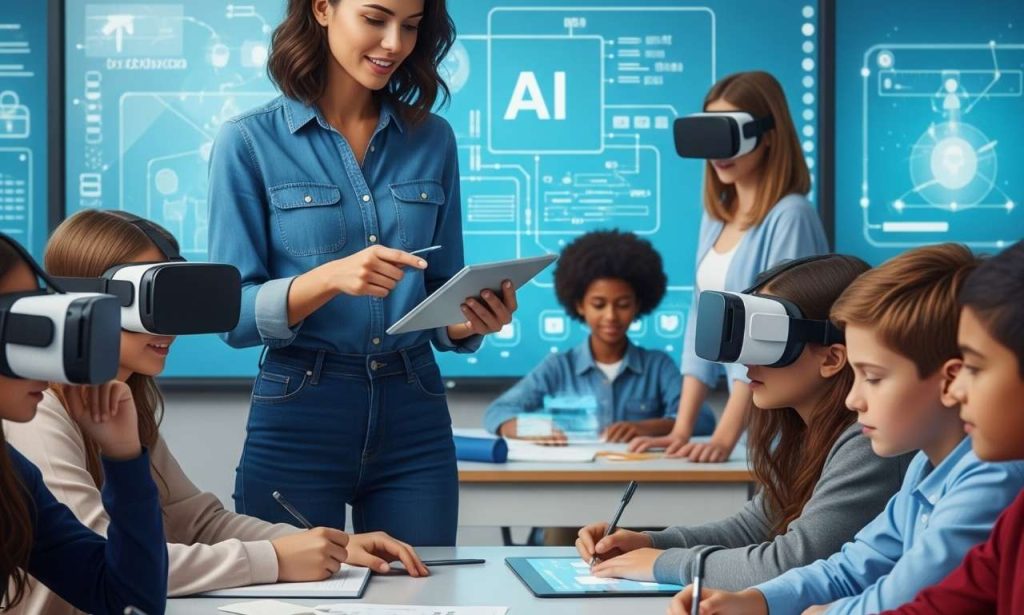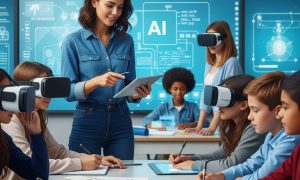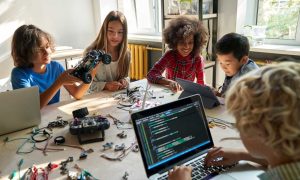Education has always been shaped by tools. Chalkboards gave way to projectors, then laptops, and now artificial intelligence. Each change promised to make teaching and learning more effective. AI, however, feels different. Why? Because it doesn’t just support learning; it reshapes it entirely. It adapts lessons, manages classrooms, and opens doors that once stayed firmly closed. Teachers no longer carry every burden alone, and students are no longer boxed into one-size-fits-all models. Here are eight benefits of AI in education, illustrating how schools, universities, and learners of all ages can benefit.
Enhanced Personalized Learning

Every teacher knows the struggle: some students finish quickly, others need more time, and balancing both is difficult. Traditional methods rarely keep everyone engaged.
Here’s where AI makes its mark. By analyzing student progress in real time, AI systems adapt lessons automatically. A struggling student receives extra practice without feeling singled out. A fast learner gets harder challenges before boredom sets in.
Personalization goes beyond pacing. Some learners respond best to visual explanations. Others prefer audio or hands-on activities. AI tools mix and match formats until the material finally clicks.
That flexibility matters. Instead of treating classrooms like assembly lines, AI ensures each student gets attention suited to their strengths. Teachers still guide the process, but with sharper tools and clearer insights.
Automated Administrative Tasks
Let’s be honest: paperwork eats into teaching time. Grading endless quizzes, logging attendance, filling schedules—none of it sparks joy. It’s necessary, but it steals hours that could be better spent.
AI cuts through the clutter. Multiple-choice grading? Done in seconds. Attendance? Logged automatically with facial recognition or simple check-in tools. Scheduling? Optimized to avoid resource clashes and teacher conflicts.
Chatbots add another layer of relief. Instead of answering routine questions about deadlines or classroom locations, AI assistants provide instant replies. Students get help anytime, and teachers avoid drowning in repetitive emails.
The result? Teachers reclaim time, students receive faster responses, and institutions save money. Nobody misses the busywork.
More Engaged Learners
Keeping students interested is harder than ever. Smartphones buzz, attention spans shrink, and old-school lectures often fail to hold focus.
AI changes the game by making lessons interactive. Gamified platforms award points, unlock levels, or celebrate milestones, turning dull exercises into motivating challenges. Virtual tutors chat with learners, encourage them when they hesitate, and explain concepts in different ways.
Add immersive tech into the mix, and classrooms feel transformed. Imagine exploring ancient Rome through VR or simulating chemistry experiments without safety risks. Those experiences stick far longer than reading a textbook paragraph.
When students actually enjoy the process, retention improves. Learning becomes less about memorizing facts and more about genuine curiosity. That shift is priceless.
Improved Accessibility
Education only works if everyone can access it. For many students, though, disabilities or language barriers make participation difficult. AI helps level the field.
Speech recognition converts spoken lessons into live transcripts, supporting students with hearing impairments. Text-to-speech reads material aloud for visually impaired learners. Instant translation tools break down language walls, giving non-native speakers an equal footing in class.
These aren’t luxuries—they’re lifelines. Without them, too many learners would remain excluded. With them, education becomes truly inclusive, demonstrating that classrooms can be tailored to meet every student’s needs.
Schools that adopt these tools send a strong message: learning belongs to everyone, no exceptions
Actionable Insights
Teachers have always collected data: test scores, attendance, and behavior notes. But raw numbers alone don’t reveal much. That’s where AI steps in, turning noise into clarity.
Algorithms highlight patterns that humans might miss. For example, a student’s attendance may dip slightly while grades slide at the same time. On paper, it’s easy to overlook. AI connects the dots and raises a flag before the problem snowballs.
Insights extend beyond individuals. Administrators identify which programs are successful, which resources are underutilized, and where improvements can be made. Parents stay informed through real-time updates, rather than waiting for term reports.
The real benefit is timeliness. Instead of reacting after students fail, educators act while success is still within reach.
More Efficient Classroom Management
Managing a classroom often feels like spinning plates. Attendance here, behavior issues there, and constant reminders about assignments. AI brings order to the chaos.
Attendance systems record entries instantly, cutting down wasted minutes. Engagement trackers notify teachers when attention levels dip, allowing quick adjustments. Scheduling platforms ensure classrooms and labs run smoothly without conflicts.
Students benefit too. Automated reminders about homework or upcoming tests reduce last-minute panic. Everyone stays on the same page without constant nagging from teachers.
Efficiency doesn’t sound exciting, but in practice it transforms the atmosphere. Less stress, more focus, and smoother routines all help learning thrive.
Better Security and Assessment Integrity
Education isn’t only about knowledge—it’s also about trust. Students must feel safe, and assessments must be fair. AI strengthens both areas.
Campus security utilizes AI-driven surveillance to identify unusual activity, restrict access, and safeguard sensitive areas. These systems respond quickly, preventing problems before they escalate.
Assessments also improve. Online exams often raise concerns about cheating. AI proctoring tools monitor eye movements, background sounds, and screen activity, discouraging dishonest behavior. Plagiarism checkers ensure written work reflects true effort.
When integrity holds firm, grades mean more. Students can trust the system, and institutions protect their reputations. Fairness becomes non-negotiable, as it should be.
Continuous Lifelong Learning and Professional Development
Graduation isn’t the end of learning. Careers evolve, industries shift, and professionals must keep up. AI makes lifelong education accessible and practical.
Adaptive platforms recommend training modules based on career paths and market trends. A software engineer might receive suggestions for cloud computing updates. A nurse may get alerts about new medical techniques.
These platforms respect time constraints too. Lessons adapt to busy schedules, offering micro-courses or bite-sized learning. That flexibility keeps professionals relevant without overwhelming them.
Teachers benefit as well. AI highlights areas where instructors might improve, offering updated resources and new teaching methods. The cycle of growth continues, ensuring classrooms stay current.
AI supports a culture where learning never stops. That’s essential in a world moving faster than ever.
Conclusion
AI is not a passing trend in education. It’s a transformation that reshapes how we teach, learn, and grow.
The 8 benefits of AI in education—from personalized lessons to secure assessments—show that classrooms can become fairer, smarter, and more inclusive. Teachers gain freedom, students feel supported, and institutions strengthen their impact.
Importantly, AI does not replace human teachers. Instead, it enhances their work, providing sharper tools and stronger support. The result is an education system ready for the demands of tomorrow.
Also Read: How to Turn Elementary Students Into Lifelong Readers
FAQs
It makes learning personal by tailoring content to each student’s strengths and needs.
By automating tasks such as grading, scheduling, and attendance tracking.
Yes. Gamified platforms, VR tools, and adaptive tutors keep students motivated.
It provides transcription, text-to-speech, and translation tools for diverse learners.




